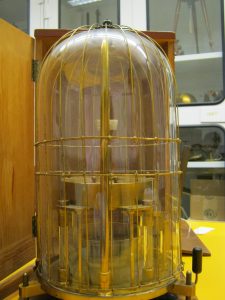Written by Mike Lally ’18
While organizing and cataloging the Science Antiques Collection Wendy and I came across a wooden box, standing about a 18 inches high and 10 inches deep.

Elliot’s Quadrant Electrometer
Inside was a mechanism that appeared to be a brass structure inside what can only be described as a birdcage. The item slides out of its carrying case on a wooden platform, which can be removed and the piece therefore is able to be lifted out of its home.
This is a Quadrant Electrometer, made by Elliott Bros. of London in the 1880s. It is a form of an electroscope, which allows more absolute measures of electrostatic potentials. This measures the presence and magnitude of a charge. When a device is attached to the contacts at the base of the machine, the needle floating inside points to the magnitude of the potential.
This machine would have been used within a classroom setting, with students learning about electrostatics. Additionally, the aesthetic qualities of this object indicate that along with its practical use, an artistic use emerges as well. One can imagine such a machine sitting in the parlor room in the late nineteenth century, guests staring at the item while its proud owner explains the machines use and provenance, yet admiring the beauty of object.
This and more aesthetically pleasing scientific instruments can be found in the 5th floor display in Bicentennial Hall.